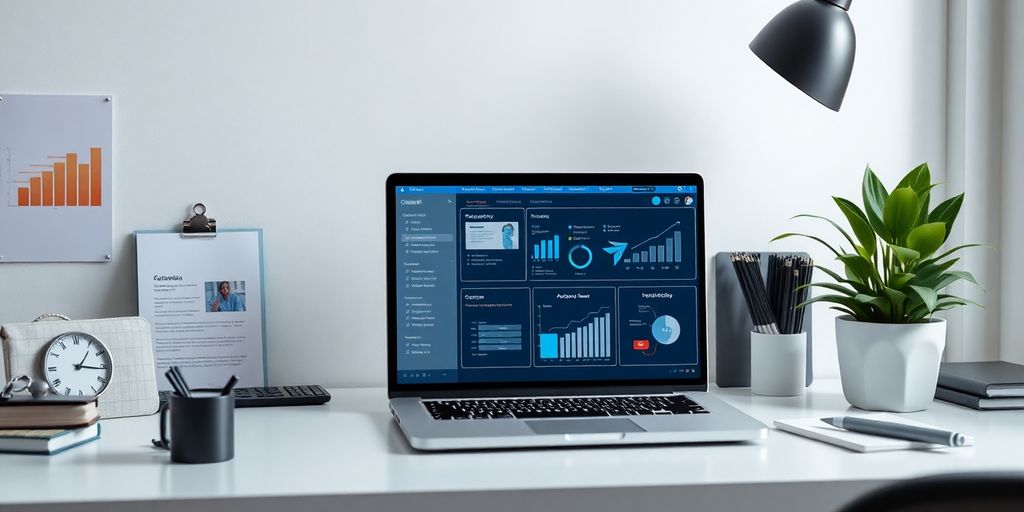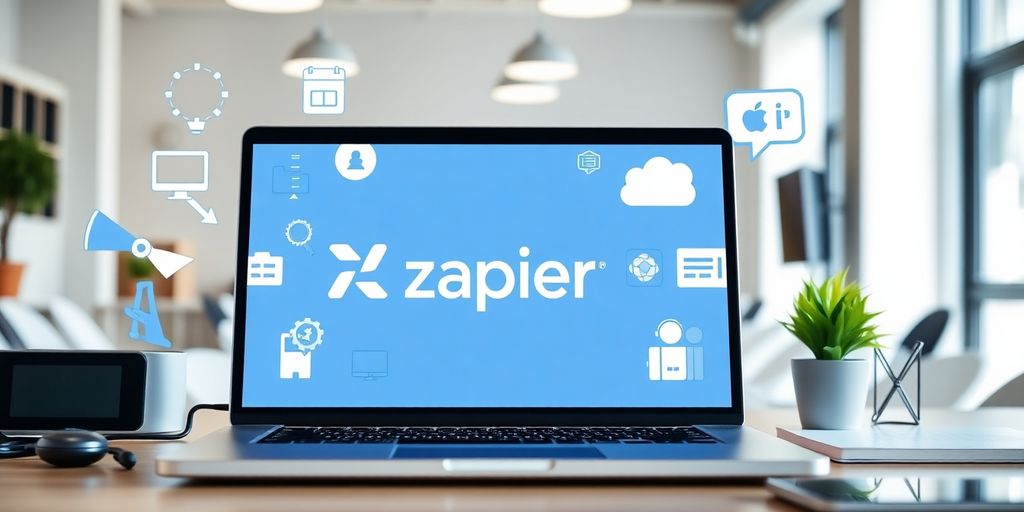Unlocking Efficiency: Mastering Zapier Automation for Your Business in 2025

Finding ways to work smarter is more important than ever. Enter Zapier automation, a tool that connects various apps and services to streamline your daily tasks. This article will guide you through the essentials of Zapier, showing you how to create effective workflows, utilize advanced features, and implement best practices that enhance your team's productivity.
Key Takeaways
- Zapier connects different apps to automate repetitive tasks, saving you time and effort.
- Creating effective workflows starts with identifying tasks that can be automated to improve efficiency.
- Advanced features like multi-step Zaps and filters allow for more complex automation tailored to your needs.
- Regularly organizing and monitoring your Zaps helps maintain their performance and effectiveness.
- Using Zapier for data insights can aid in making informed business decisions through automated reporting.
Understanding Zapier Automation

What Is Zapier?
Zapier is a tool that lets you connect different apps and services you use every day to automate tasks. Think of it as a bridge between your favorite online tools. It moves information between them automatically, so you don't have to do it manually. Zapier can save you a lot of time and effort.
How Zapier Works
Zapier works using something called "Zaps." A Zap is an automated workflow that connects your apps. It has two main parts: a trigger and an action. The trigger is what starts the Zap, like getting a new email. The action is what happens after the trigger, like saving the email attachment to your cloud storage. When a trigger event occurs, Zapier automatically performs the action you've set up. This automated workflow can really streamline your processes.
Here's a simple example:
- Trigger: New lead in Google Sheets.
- Action: Add lead to CRM.
- Result: Automatically adds new leads to your CRM without manual data entry.
Benefits of Using Zapier Automation
Using Zapier can bring a lot of good things to your business. Here are a few:
- Saves Time: Automate repetitive tasks so you can focus on more important things.
- Reduces Errors: Automation reduces the chance of human error in data entry and transfer.
- Increases Efficiency: Workflows run automatically, making your business processes faster and more efficient.
Zapier helps businesses automate tasks, reduce errors, and save time. It's a great way to make your business run smoother and more efficiently. By automating repetitive tasks, you can free up your time to focus on more important things, like growing your business.
Creating Effective Workflows
Identifying Key Tasks for Automation
Okay, so you're ready to automate. Great! But where do you even start? Don't just jump in and automate everything. That's a recipe for disaster. Instead, take a step back and really think about your daily, weekly, and monthly tasks. Which ones are repetitive? Which ones eat up a lot of time but don't require a ton of brainpower? Those are your prime candidates for automation.
Here's a simple way to approach it:
- List everything: Write down every task you do, big or small.
- Categorize: Group similar tasks together.
- Prioritize: Which tasks, if automated, would give you the biggest time savings?
Think about the tasks that consistently interrupt your focus. Automating those can have a huge impact on your overall productivity.
Designing Your First Zap
Alright, you've identified a task. Now it's time to build your first Zap! This might sound intimidating, but Zapier makes it pretty straightforward. A Zap is essentially a workflow that connects two or more apps. It has a trigger (something that starts the Zap) and an action (what the Zap does after the trigger). For example, a trigger could be a new lead form submission, and the action could be adding that lead to your CRM.
Here's a basic outline:
- Choose your trigger app: What app will start the Zap?
- Choose your trigger: What event in that app will start the Zap? (e.g., new email, new form submission)
- Choose your action app: What app will the Zap interact with?
- Choose your action: What will the Zap do in that app? (e.g., create a contact, send an email)
- Connect your accounts: Zapier will walk you through connecting your accounts for each app.
- Map your data: Tell Zapier which data from the trigger app should go where in the action app. This is where you tell Zapier to put the lead's name in the "First Name" field in your CRM, for example. See how to design reliable multi-step LLM workflows.
Testing and Optimizing Your Zaps
Testing is absolutely crucial. Don't just assume your Zap works perfectly the first time. After you've created your Zap, Zapier will give you the option to test it. Use real data to make sure everything is flowing correctly. Does the data end up in the right place? Are there any errors? If something isn't working, Zapier will usually give you a helpful error message to point you in the right direction.
Optimization is an ongoing process. Once your Zap is live, keep an eye on it. Is it running smoothly? Are there any bottlenecks? Can you make it more efficient? Here are some things to consider:
- Speed: How long does it take for the Zap to run? Can you speed it up by simplifying the workflow?
- Accuracy: Is the data being transferred correctly? Are there any errors?
- Efficiency: Is the Zap doing exactly what you need it to do, and nothing more?
Advanced Features of Zapier
Multi-Step Zaps Explained
Okay, so you've got the basics down. Now it's time to get serious. Multi-step Zaps are where Zapier really starts to shine. Instead of just one trigger leading to one action, you can chain together multiple actions. Think of it as a domino effect for your tasks. For example, a new lead in your CRM could trigger a Slack notification, create a task in Asana, and add the contact to your email list. It's all about automating complex workflows.
Using Filters and Paths
Filters and Paths are your secret weapons for making Zaps smarter. Filters let you specify conditions that a Zap must meet before continuing. For instance, only create a task in Asana if the lead's value is over $1,000. Paths, on the other hand, let you create different outcomes based on different conditions. Maybe leads from California go to one sales rep, while leads from New York go to another. It's all about customizing your automation.
Integrating with Webhooks
Webhooks are a bit more technical, but they open up a whole new world of possibilities. Basically, they let Zapier talk to apps that don't have a direct integration. It's like building your own custom connections. You can use webhooks to:
- Send data to a custom API.
- Receive data from a service that doesn't have a Zapier app.
- Create highly customized workflows.
Webhooks might seem intimidating at first, but don't let that scare you. There are tons of tutorials and resources online to help you get started. Once you understand the basics, you'll be amazed at what you can do.
Here's a simple example of how filters can save you time:
Best Practices for Zapier Automation
Organizing Your Zaps
Okay, so you've got a bunch of Zaps running. Great! But now what? It's super easy for things to get messy real fast. That's why organization is key. Think of it like your digital workspace – if it's a mess, you're not going to be productive.
Here's what I do:
- Naming Conventions: Come up with a system. For example,
[App1] to [App2] - [Task]. This makes it easy to see what each Zap does at a glance. - Folders: Use folders to group Zaps by department, project, or function. This is a lifesaver when you have dozens (or hundreds!) of Zaps.
- Descriptions: Add a clear description to each Zap. Explain what it does, why it exists, and any important details. Future you will thank you.
It's easy to skip organizing when you're first setting up Zaps, but trust me, it's worth the effort. A little bit of organization upfront can save you a ton of time and headaches down the road.
Monitoring Performance
So, your Zaps are set up, but are they actually working? You need to keep an eye on things. Zapier has a built-in monitoring system, so use it! Regularly check your Zap history to see if any Zaps are failing.
Here's what to look for:
- Error Rates: Are any Zaps consistently failing? This could indicate a problem with the connection, the apps themselves, or the Zap's logic.
- Execution Time: How long are your Zaps taking to run? If they're slow, you might need to optimize them.
- Data Accuracy: Is the data being transferred correctly? Double-check to make sure everything is working as expected. Consider using Zapier Agents to monitor and manage your Zaps.
Troubleshooting Common Issues
Okay, so something's gone wrong. Don't panic! Here are a few common issues and how to fix them:
- Connection Errors: Make sure your apps are still connected to Zapier. Sometimes connections expire or need to be re-authenticated.
- API Changes: Apps sometimes change their APIs, which can break your Zaps. Check the app's documentation or Zapier's help center for updates.
- Data Formatting: Make sure the data being passed between apps is in the correct format. Use Zapier's Formatter tool to transform data if needed.
If you're still stuck, Zapier's support team is pretty good. Don't be afraid to reach out for help!
Enhancing Team Collaboration with Automation
Streamlining Communication
Zapier can seriously cut down on the back-and-forth emails and messages that eat up everyone's time. Think about automatically posting updates to a shared Slack channel when a new project task is created in Asana, or sending out daily summaries of important information. This keeps everyone in the loop without constant manual updates.
- Automate notifications for project updates.
- Consolidate communication channels.
- Share key data points automatically.
By automating routine communication, teams can focus on more strategic discussions and problem-solving, rather than getting bogged down in administrative tasks. This not only saves time but also reduces the risk of miscommunication and errors.
Automating Project Management
Project management can be a real headache, but Zapier can help smooth things out. Imagine automatically creating tasks in your project management tool when a new lead comes in through your website, or updating task statuses based on email replies. This kind of automation keeps projects moving forward without constant manual intervention. You can even connect project management tools to keep everyone on the same page.
- Automatically create tasks from new leads.
- Update task statuses based on triggers.
- Sync deadlines across platforms.
Integrating Team Tools
One of the coolest things about Zapier is how well it connects different apps. You can link your CRM, email, calendar, and project management tools to create a unified workflow. For example, when a new meeting is scheduled in Google Calendar, Zapier can automatically create a corresponding task in Asana and send a notification in Slack. This integration eliminates the need to switch between apps and manually transfer information. Here's a simple example:
Leveraging Data for Strategic Insights
Automated Reporting
Okay, so you've got all these Zaps running, automating different parts of your business. But what about the data they're generating? That's where automated reporting comes in. Think of it as turning your Zapier workflows into a data-generating machine. Instead of manually pulling reports from each app you use, Zapier can do it for you. For example, you could set up a Zap to automatically create a weekly sales report from your CRM data and send it to your team. It's about making the data work for you, not the other way around.
Data Consolidation Techniques
Having data spread across multiple apps is a common problem. It's like trying to solve a puzzle when all the pieces are in different boxes. Zapier can help you consolidate that data into a single, unified view. Data consolidation is key to getting a clear picture of what's going on in your business. Here are a few ways to do it:
- Use Zapier to copy data from one app to another (e.g., from your CRM to a spreadsheet).
- Create a data warehouse using a tool like Google BigQuery or Amazon Redshift, and use Zapier to feed data into it.
- Use Zapier to trigger a data visualization tool like Tableau or Google Data Studio to create dashboards.
Using Zapier for Analytics
Zapier isn't just about moving data around; it can also be a powerful tool for analytics. You can use it to track key metrics, identify trends, and gain insights into your business performance. For example, you could use Zapier to:
- Track the number of new leads generated each month.
- Monitor customer satisfaction scores.
- Identify the most popular products or services.
By connecting Zapier to your analytics tools, you can automate the process of data collection and analysis, freeing up your time to focus on making strategic decisions. It's about turning raw data into actionable insights that can drive business growth.
Future Trends in Automation

Emerging Technologies
Automation is no longer a static field; it's constantly evolving thanks to emerging technologies. We're seeing more sophisticated integrations with IoT devices, allowing for automation that responds to real-world conditions in real-time. Think automated adjustments to your office environment based on occupancy and energy use. Also, blockchain is starting to play a role, providing secure and transparent automation processes, especially in supply chain management and financial transactions.
The Role of AI in Automation
AI is poised to revolutionize automation. Instead of just following pre-set rules, AI-powered automation can learn, adapt, and make decisions. This means more complex tasks can be automated, and workflows can be optimized on the fly. We'll see more AI-driven tools that can analyze data, predict outcomes, and adjust automation processes accordingly. However, businesses should be wary of AI startups that may overstate their capabilities in 2025 AI capabilities.
Preparing for Changes in Workflow Automation
Workflow automation is becoming more accessible and user-friendly, but that doesn't mean it's becoming less complex. To prepare for the future, businesses need to:
- Invest in training and development to ensure employees have the skills to manage and optimize automation systems.
- Focus on building flexible and adaptable workflows that can easily be modified as business needs change.
- Prioritize data security and privacy to protect sensitive information in automated processes.
The key to success in the future of automation will be a combination of technological expertise and strategic thinking. It's not just about automating tasks; it's about automating the right tasks in the right way to achieve specific business goals.
Wrapping It Up
In the end, using Zapier for automation can really change the game for your business. It connects different apps and makes your daily tasks a lot easier. By getting the hang of how it works, you can save time and reduce mistakes, which is a win-win. Just keep in mind that it’s all about how you set things up and keep them running smoothly. Regular check-ins on your Zaps will help you catch any issues and keep everything working well. So, dive in, experiment, and watch your efficiency soar!
Frequently Asked Questions
What is Zapier and how does it work?
Zapier is a tool that connects different apps and automates tasks between them. It works by setting up 'Zaps', which are workflows that trigger actions in one app based on events in another.
What are some benefits of using Zapier for my business?
Using Zapier can save you time by automating repetitive tasks, reduce errors by syncing data between apps, and improve overall efficiency in your workflows.
How do I create my first Zap?
To create your first Zap, start by choosing a trigger app and an event that will start the Zap. Then, select an action app and what you want it to do when the trigger happens.
What are multi-step Zaps?
Multi-step Zaps allow you to connect more than two apps in a single workflow. This means one trigger can lead to several actions across different apps.
How can I troubleshoot issues with my Zaps?
If a Zap isn't working, check the task history for error messages. You can also review the settings of the apps involved to ensure everything is set up correctly.
What are some best practices for using Zapier?
Some best practices include organizing your Zaps for easy access, regularly monitoring their performance, and testing them to make sure they work as intended.
%20(2).png)



